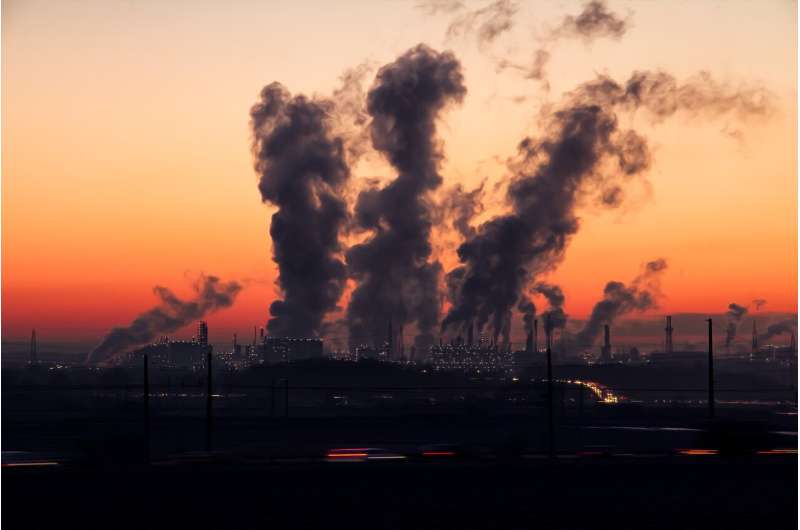This article has been reviewed according to Science X's editorial process and policies. Editors have highlighted the following attributes while ensuring the content's credibility:
fact-checked
trusted source
written by researcher(s)
proofread
Scientists recreate alveolar epithelium in a lab to understand how polluted air can affect your health

Even today, in a world increasingly powered by renewable energy and clean technologies, air pollution poses a real risk to human health. In the UK alone, it is estimated to be responsible for 28,000 to 36,000 deaths every year, and can vastly increase the risk of developing many lung and heart-related diseases, such as asthma or lung cancer.
Polluted air forms a complex mixture that changes depending on where the pollution is coming from, and what the local weather is doing at the time. People in towns and cities are more at risk since they live closer to most cars, factories and other sources of emissions.
Although there are many different types of pollutants within the air we breathe, two in particular are detrimental to our health: the gas nitrogen dioxide (NO₂) and particulate matter (specifically, PM2.5), formed of floating, microscopic solid or liquid particles smaller than 2.5 micrometers in diameter (for reference, a human hair is about 70 micrometers in diameter).
In 2017, a report found that all areas of London exceeded World Health Organization recommended levels for PM₂.₅, with many areas being more than double the recommended levels. Scenarios like these have allowed researchers to investigate the dangers of breathing in really polluted air.
One study found that, across the world, 86% of people who live in urban areas are exposed to PM₂.₅ at levels higher than even the World Health Organization's more lenient 2005 guidelines, resulting in 1.8 million excess deaths in 2019. Another found NO₂ to be responsible for 1.85 million cases of childhood asthma worldwide in 2019.
These figures come from studies on large populations of people, which take public health data and compare it to pollution data to look for correlations between pollution and disease. These are known as epidemiological studies. Although these studies can provide great insight into the risks associated with air pollution exposure, they do have their limitations.
For example, NO2 and PM2.5 are emitted from the same sources, so you'd expect that when levels of one pollutant are high, levels of the other are high too. Therefore, without some very complicated math, it's sometimes hard to use epidemiological data to fully tease out the health effects of one pollutant compared to another.
For this reason, research needs to take place in a more controlled environment. This can be achieved in a laboratory setting either by using invasive animal testing strategies, or by implementing cell-based systems of human cells that represent the organ in a dish.
Lungs in a lab
In our lab at Swansea University Medical School, we are trying to replicate the layer of cells known as the alveolar epithelium, which lines the deepest part of your lungs where oxygen enters your bloodstream and carbon dioxide leaves as you breathe in and out. This means it's also a key area that air pollution can target and damage. We therefore want to understand how pollution affects this specific and very delicate body part.
The alveolar epithelium is made up of several different types of cells, each with a specific job. Some allow movement of gases into and out of the blood, some produce surfactant (a biological fluid that maintains the structure of the lower lung as one breathes in and out) and some help remove inhaled microbes and particles.
By mixing all these cells together at specific ratios, we can produce single layers of cells that look very much like the alveolar epithelium of healthy humans. Then, once we've grown these anatomically relevant alveolar models, we can expose them to various pollutants to investigate what effect they may have.
We use "standardized" urban or indoor dust particles, which allows us to compare results with those from other labs who might also be using these particles (although realistic particles taken straight from the air around us are also sometimes used). We then put them in an aerosol cloud that deposits the particles onto the cells in a way that mimics the inhalation of particles in real life.
We've also devised a state-of-the-art NO2 chamber that we can put the cells into. This allows us to see what happens to the cells when grown in differing NO2 concentrations.
By investigating the effects of NO2 and PM2.5 separately, we can fill in the gaps left by epidemiological studies to find out how individually hazardous each particle is—and whether being exposed to both at once is worse than being exposed separately.
Initially, we are finding that NO2 and PM may work in tandem to damage important cells within the lower lung.
Our results will hopefully improve our knowledge of how air pollution may damage the important cell types within the human (lower) lung, contributing to the onset or exacerbation of disease. Such findings would contribute to the human health assessment of exposure to air pollution, helping to develop future, relevant guidelines.
This article is republished from The Conversation under a Creative Commons license. Read the original article.![]()




















